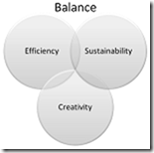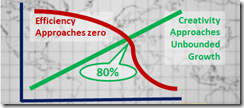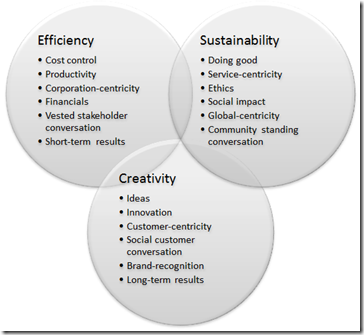 Earlier, I shared that we need to shift from efficiency to creativity. This is not a stop-start switch from all efficiency measures, replacing them with creative initiatives that generate new ideas, innovation, and growth. This is about balancing three important factors – creativity, efficiency and sustainability. If done well, balancing these three factors builds strong learning and high-performance organizations. It strengthens businesses with new ideas for products and services to complement business from existing products and services – and, in a word, drives growth.
Earlier, I shared that we need to shift from efficiency to creativity. This is not a stop-start switch from all efficiency measures, replacing them with creative initiatives that generate new ideas, innovation, and growth. This is about balancing three important factors – creativity, efficiency and sustainability. If done well, balancing these three factors builds strong learning and high-performance organizations. It strengthens businesses with new ideas for products and services to complement business from existing products and services – and, in a word, drives growth.
Why it’s A Dilemma Now
Many companies, led by executive teams and boards of directors, have a natural propensity to overdo efficiency in lieu of creativity and sustainability. After all, management, academia, MBAs and corporate culture have driven this reaction for two hundred years. We’re good at it. Creativity and Sustainability is hard to teach, do, and measure.
Efficiency it was thought would ride the recession out, while the government stimulated spending through economic engineering. The cost of efficiency actions was usually funded by cuts to creativity and sustainability activities. The people and initiatives that generated ideas, innovation and new products and services were cut. The revenue and growth from these terminated projects was not to be realized. These creative things that we so easily cut are the true solution to a recession.
A Different Economy
Efficiency measures worked for recent short-lived US recessions of 2001, 1990, 1981 and 1974. According to the National Bureau of Economic Research (NBER), these recessions were from 6 to 18 months. The current recession started in December 2007, according to the NBER and is now measured in years, is global in reach and has international dependencies.
By having a recession last for over 4 years, we have learned that efficiency measures are important, but cannot bring us out of a global recession. We’ve also learned efficiency measures  drive economic shrinking, not growth. Innovation and firm creation is the only driver of true sustained economic growth, we know from Kaufman Foundation research. It takes creativity to innovate and create firms.
drive economic shrinking, not growth. Innovation and firm creation is the only driver of true sustained economic growth, we know from Kaufman Foundation research. It takes creativity to innovate and create firms.
Apply the 80/20 rule, recognizing that the last 20% of efficiency measures cost too much in other terms to implement for too little gain. More innovation will always produce better results. No CEO regrets delivering a successful product to market, especially in a recession. To have more successful products that add incremental revenue and growth to the bottom line, one has to invest (in a balanced way) in innovation.
Example of Efficiency Suicide
Existing products become obsolete over time. Without innovating new products and services, too much focus on operational efficiency accelerates obsolescence and results in corporate suicide. Companies are only just now learning how serious this is.
I recently learned of a direct mail company that had invested in dozens of new, highly efficient machines. The machines printed, folded, applied postage, and sorted direct mail. Immediately after taking delivery, the machines were silent and became dust-covered. Clients had moved on to email and social media engagement. This company had been left behind. It improved efficiency at the expense of creativity and sustainability ideas that would have innovated new strategies to reach prospective customers and generate business from its clients. It had become obsolete. It had committed suicide.
Leadership Focus
Why have I focused on the role, responsibility and sometimes failure of the executive team and boards of directors? Generally, business leaders today with MBAs have a common background when it comes to their understanding and leadership action around creativity, efficiency and sustainability.
The core of MBA curriculum is operations-focused and efficiency-centric. So many of these functions are now outsourced to special operations-focused firms, but leadership has not yet refocused it’s energy on creativity.
Generally, MBA courses have remained static for decades, teaching a core of leadership, strategy, finance, accounting operations, economics and marketing with one elective. By the nature of academia’s semester timeframes, projects focus on solving a bounded problem with a short-term solution. Leaders we are training are naturally predisposed to a rearward looking case-study method, focused on “fixing inefficiency.” Case-study helps us to learn from others’ failures, but little is taught on the active thought process of creative innovation from new and unique ideation. Or the balance of creativity, efficiency and sustainability such that fixing inefficiency could be less necessary as declining products become obsolete and are replaced with new innovation.
Only Marketing and Strategy courses seem to touch on ideation and design-thinking for new, unique creative solutions. Even traditional Leadership courses are really management courses as they are focused on motivating employees to do what management wants them to do with negotiation, conflict resolution, and other “problem-solving” situational management challenges on the side.
True leadership is about serving the organization and creating a corporate culture such that it naturally thinks creatively, and delivers innovation and drives greatness. True leadership is about creating an environment that celebrates failure as a step toward an innovation the will become the next new product or service – and result in real growth for the company.
Creativity, Efficiency and Sustainability Factors
What are these three factors and why are they important? Let’s look at each one.
Efficiency
Efficiency is a domain of cost control, productivity, and financial measures. These are all internally focused and corporation-centric. Customers don’t care about efficiency from this perspective. The processes and the people in these roles are not directly in touch with the customer, generally. The goal of an efficiency measure is to ensure the next short-term result and deliver on vested stakeholder (in a stockholder or business ownership sense) expectations. Efficiency timeframes are short-term and are set in conversations at the last board meeting, quarterly review or shareholder meeting. It’s easy to see how efficiency thinking can lose track of the customer, and the resulting customer-company relationship that generates revenue through new industry/customer requirements that the company must deliver in terms of new and sustained value.
Creativity
Creativity is the mind, soul and heart of a company that it cannot survive without. Like the human, if you rip out its soul, it loses will to produce, and has no purpose. If you rip out its heart, it ceases to live altogether. If you rip out its mind, it ceases to think and make good decisions when management is not around.
We all know companies that do creativity poorly. They are the ones that had a single, often maniacal, leader that had to make every decision. People in them were paralyzed and lived in fear for their jobs. These are static companies that eventually fall prey to competitors.
To avoid this scenario, creativity in corporate culture must be actively nurtured and visibly enabled by leaders. Ideas and innovation in terms of process, failure and eventual success must be celebrated. People in this organization have daily infusions from the creative types in design and marketing departments. Often, they are led by creative CEOs that like to listen, and have a brainstorming conversation with anyone that has an idea. These CEOs often don’t come up through the ranks of finance and accounting. They are less recognized for cutting, reducing, constricting and demoralizing to profitability. They are instead creative types that generated incremental new growth through creativity. They maximize success through innovation such that any loss due to inefficiency is relatively insignificant and unnoticed. This kind of company is proudly visible and recognized as an industry leader by customers and analysts because they are actively engaged in the social conversation with the global communities they serve. They focus on Long-term, sustainable results.
Sustainability
As a factor, sustainability is much more important than being green and environmentally friendly. That is only a small part of it. Balancing sustainability is the factor that ensures people are thinking about today with the same sense of importance today as they know it will have tomorrow, next week, next month and next year. It is the sense that the organization is a living part of a bigger business and global ecosystem, and that by doing good through a service-centric approach, the values expressed will come back in multiples. The companies that know the importance of sustainability balanced with creativity and efficiency live values and ethics that ensure social impact that the organization operating in a sustainable way. This factor makes companies proud of its actions today, and tomorrow, while having an open conversation with business stakeholders, customers, non-customers and competitors alike. If collaborating broadly, even with competitors, can provide benefit for the global community, companies that live sustainability make the right, balanced choices because in the long-run, they benefit the business, its brand and produce results. That is what sustainability truly is.
To Ponder
Think back at the companies you have worked in. Consider the leaders there, the executive team, and the boards that governed them. What were the values there? Were they lived by the leaders? There are good stories and motivational anecdotes you have to share that can help other leaders find insight as they progress through their fourth year of recession.
Share a thought that can benefit others as they read and learn from your balance perspective.










Andrew,
Your post demonstrates a form of thought leadership that seems dormant right now. If you’re not writing an ‘app’ the odds are ‘creativity’ is not part of your company’s vocabulary…not a word on the front of your tongue.
The comments you make about an MBA are fair. They use history (case studies) as a learning tool looking into the future. The MBA has great value in providing insight, a baseline of higher business knowledge, than students might obtain on their own (in accelerated fashion).
That said, they do tend to stop| Right at the point where it is important to look –forward– and figure out how to apply the knowledge. Like a trauma center: we’ve stopped the blood loss, the patient’s not going to die (right now), now…where do we go from here?
The U.S. has often been viewed as the most creative, the most innovative, and most dynamic. We run the risk of losing that most-valuable-of-traits if we don’t get ourselves out of our proverbial fox holes.
Good piece.